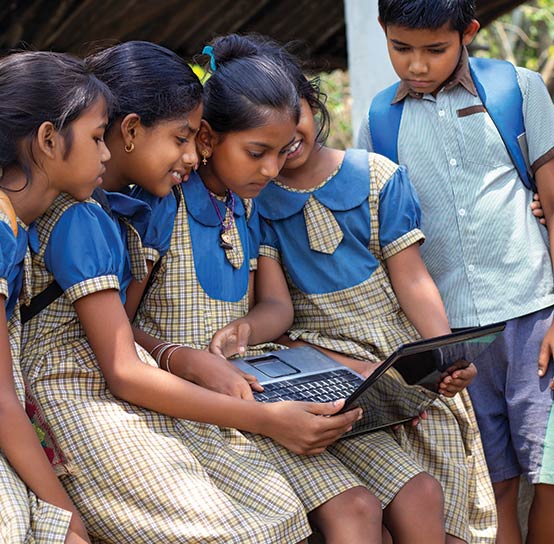-
Business Consulting
Our business consulting specialists offer a comprehensive blend of strategic advisory services. We assess the business, industry, operating model, synergy, skill sets and vision of the organisation and recommend the way forward
-
Digital Transformation Services
Grant Thornton’s digital transformation services help traditional businesses digitalise their business models with cloud technology, IoT consulting, app development and more DigiTech solutions.
-
Human Capital Consulting
Our Human Capital Consulting team harnesses technology and industry expertise to assist in constructing adaptable organisations with transparency, fostering productive and value-driven workforces, and inspiring employees to engage meaningfully in their tasks.
-
Production Linked Incentive Scheme
Production-linked Incentive Scheme by the Indian government is aimed at boosting manufacturing. Grant Thornton Bharat offers varied services across sectors to help businesses avail of this scheme.
-
Public Sector Advisory
Our Public Sector Advisory team has focused streams, aligned with the core priorities of the Government of India. We are responsible for providing innovative and customized technical and managerial solutions.
-
Tech Advisory
We have amalgamated Digital Transformation, IT Advisory & Information Management and Analytics into a new offering, DigiTech.
-
Direct Tax services
Our tax specialists offer a comprehensive blend of tax advisory, tax litigation, regulatory and compliance services, helping you navigate through complex business matters.
-
Indirect Tax Services
Get tax advisory service by leading tax firm Grant Thornton India. Our indirect tax services include advisory, compliance and litigation services for corporate, international and transaction tax
-
Transfer pricing services
Our transfer pricing services experts provide a range of services from provision of APA services to handling large global assignments including Country by Country reporting.
-
US Tax
At Grant Thornton, we help individuals and dynamic companies deal with US tax laws, which are one of the most complicated tax legislations across the world.
-
Financial Services - Tax
Best financial advisory services, tailored for small and large businesses by the experts having comprehensive knowledge of domestic laws and access to multifaceted tools to provide a valuable results.
-
Financial Reporting consulting services
Our experts have significant hands-on experience in providing IFRS/US GAAP services, end-to-end solutions and support services to fulfil financial reporting requirements.
-
Fund accounting and financial reporting
International operations often lack standardisation and have varied local reporting formats and requirements. Our experts can offer proactive insights, practical guidance, and positive progress and help meet regulatory timeframes.
-
Compliance and Secretarial Services
Our experts can assist in overhauling the entire compliance machinery of the organisation through evaluation of the applicable statutory obligations, monitoring of adequate governance controls, reporting and providing ongoing support.
-
Global People Solutions
As businesses transcend borders, both domestic and global considerations need equal attention. Our interim CFO and financial controller support services help organisations meet the business vision.
-
Finance and accounting outsourcing
Our accounting experts assist organisations in managing their accounting and reporting. Our dedicated Integrated Knowledge and Capability Centre (IKCC), allows us to service both the domestic and global markets efficiently and cost-effectively
-
Compliance Management System
We have automation solutions for you that will allow meeting government requirements and remain diligent, which when failed, can lead to penalties and loss in revenue.
-
IKCC: Grant Thornton's Shared Service Centre
The India Knowledge and Capability Centre (IKCC), aimed at delivering solutions by developing capabilities, has completed four years of its journey.
-
Global compliance and reporting solutions
At Grant Thornton Bharat, we meet the challenges of our clients and help them unlock their potential for growth. Our professionals offer solutions tailored to meet our clients’ global accounting and statutory reporting requirements. With first-hand experience of local reporting requirements in more than 145+ locations worldwide, we provide seamless and consistent international service delivery through a single point of contact.
-
Related Party Transactions Governance
Related Party Transactions Governance
-
Private Client Services
Private Client Services
-
Labour codes
Labour codes solutions help you transition through the new legislation. At Grant Thornton, we help businesses divide their approach to make sure a smooth transition.
-
Alerts
At Grant Thornton India, with the help of our tax alerts, we help to provide updates on how to minimise your tax exposure and risks.
-
Cyber
In today’s time, businesses have gone through large transformation initiatives such as adoption of digital technologies, transition to cloud, use of advanced technologies et al.
-
Governance, Risk & Operations
Our Governance, Risk and Operations (GRO) services encompass Internal Audit, Enterprise Risk Management, Internal Financial Controls, IT advisory, Standard Operating Procedures and other services.
-
Risk analytics
Grant Thornton Bharat’s CLEARR Insights is a state-of-the art data analytics platform that will help you in seamless data analysis and efficient decision-making.
-
Forensic & Investigation Services
The team of forensic advisory services experts consists of the best intelligence corporate experts, and fraud risk, computer forensic experts to deliver most effective solutions to dynamic Indian businesses.
-
ESG consulting
Grant Thornton Bharat offers holistic ESG consulting solutions for sustainable business outcomes. With industry expertise and AI technology, we drive long-term value.

-
Transaction Tax Services
Our transaction tax experts understand your business, anticipate your needs and come up with robust tax solutions that help you achieve business objectives ensuring compliance and efficiency
-
Deal Advisory
Unlike other M&A advisory firm in India, we offer deal advisory services and work exclusively with controlled and well-designed strategies to help businesses grow, expand and create value.
-
Due Diligence
Grant Thornton’s financial due diligence services are aimed at corporate looking for mergers and acquisitions, private equity firms evaluating investments and businesses/promoters considering sale/divestment.
-
Valuations
As one of the leading valuation consultants in India, Grant Thornton specializes in all the aspects of the process like business valuation services, financial reporting, tax issues, etc.
-
Overseas Listing
Overseas listing presents a perfect platform for mid-sized Indian companies with global ambitions. Grant Thornton’s team of experts in listings, work closely with clients during all stages.
-
Debt & Special Situations Solutions
Grant Thornton Bharat offers specialist debt and special situations consulting services, including restructuring, insolvency, and asset tracing solutions.
-
Financial Reporting Advisory Services
Financial Reporting Advisory Services
-
Financial Statement Audit and Attestation Services
Financial Statement Audit and Attestation Services

- Agriculture
- Asset management
- Automotive and EV
- Aviation
- Banking
- Education and ed-tech
- Energy & Renewables
- Engineering & industrial products
- FinTech
- FMCG & consumer goods
- Food processing
- Gaming
- Healthcare
- Urban infrastructure
- Insurance
- Media
- Medical devices
- Metals & Mining
- NBFC
- Pharma, bio tech & life sciences
- Real estate and REITs
- Retail & E-commerce
- Specialty chemicals
- Sports
- Technology
- Telecom
- Transportation & logistics
- Tourism & hospitality
-
India-UK
India-UK

The world is emerging from more than two years of a pandemic-induced economic slowdown, while also grappling with the impact of the war in Ukraine, and inflationary pressures resulting from increased spending counter the fallout from lockdowns due to COVID-19. India is no different and has limited fiscal space to increase spending. While on target to achieve a fiscal deficit of 6.4 per cent this financial year, significant efforts are needed to meet the target of 4.5 per cent set for FY26. As the last full Budget before next year’s general elections, all eyes were on this year’s Budget to see the direction the government would take on India’s economic roadmap.
The reality of this situation created a need for a budget that while prudent in outlay, also ensured the upliftment of the most vulnerable, reduced inequality, and drove grassroot level development to ensure that no one is left behind. Thus, there was a need for reprioritisation, with an increased focus on inclusive development, green growth, last mile delivery, youth, agriculture, and rural development. In addition, there has been a recognition that efficiency needs to be ramped up as well, and the budget places a focus on technology driven, digital interventions to drive service delivery.
While allocation to most schemes has remained mostly the same, some strategic schemes have seen increased allocations, and new schemes have been announced to ensure that no one is left behind. Existing schemes like Jal Jeevan Mission and the Pradhan Mantri Awas Yojana – Grameen have seen a significant jump in outlay. New schemes have also recognised the need for efficiency by creating integrated schemes for delivery of social services and basic infrastructure. The Pradhan Mantri Particularly Vulnerable Tribal Groups Development Mission (PMPVTGDM), for which Rs. 15,000 crore has been allocated, and the Aspirational Blocks Programme, both aim to ensure delivery of basic infrastructure to areas which are currently lagging, thus ensuring holistic social development.
The agriculture sector also saw several announcements to drive efficiency, improve cropping patterns and create livelihood opportunities with the announcement of the Clean Plant Program, an Agriculture Accelerator Fund, push for the creation of storage infrastructure, and increased targets for agriculture credit.
Bolstering its credentials for inclusive development and gender sensitive growth, the government has announced a plan to bring together India’s 81 lakh women self-help groups (SHGs) to create large producer enterprises who shall be trained to professionally manage their entrepreneurial endeavours and provided with quality materials to create enhanced products and PM VIKAS, a new scheme to support artisans and handicraft creators and integrate them into the MSME value chain.
The health sector also saw future-looking policies on research and development. The government also announced a mission to eliminate sickle cell anaemia, a disease which disproportionately impacts vulnerable groups, especially tribal people, by 2047, showing a commitment to solving large scale public health issues.
However, there are still some areas which need to be addressed. The allocation to the Mahatma Gandhi National Rural Employment Guarantee Scheme (MGNREGS) has seen a further reduction, a continuing trend. With unemployment in rural India steadily increasing, such a decision may need to be relooked at when the revised estimates of the budget are released.
Furthermore, while large medical health infrastructure has been identified as a priority area, outlay on pharmacovigilance and disease preparedness have not seen a major increase. As we see increased reports of adverse drug reactions (ADR) and instances of animal to human transmission of zoonotic diseases, there is a need for specialised infrastructure and focus in these areas.
Largely prudent and responding to immediate social sector needs, we will need to see how these reforms play out. However, it is safe to say that the budget has created a platform on which the most vulnerable persons in society can be served through government programmes in an efficient, integrated, and sustainable manner.
This article was originally published in news18.com.